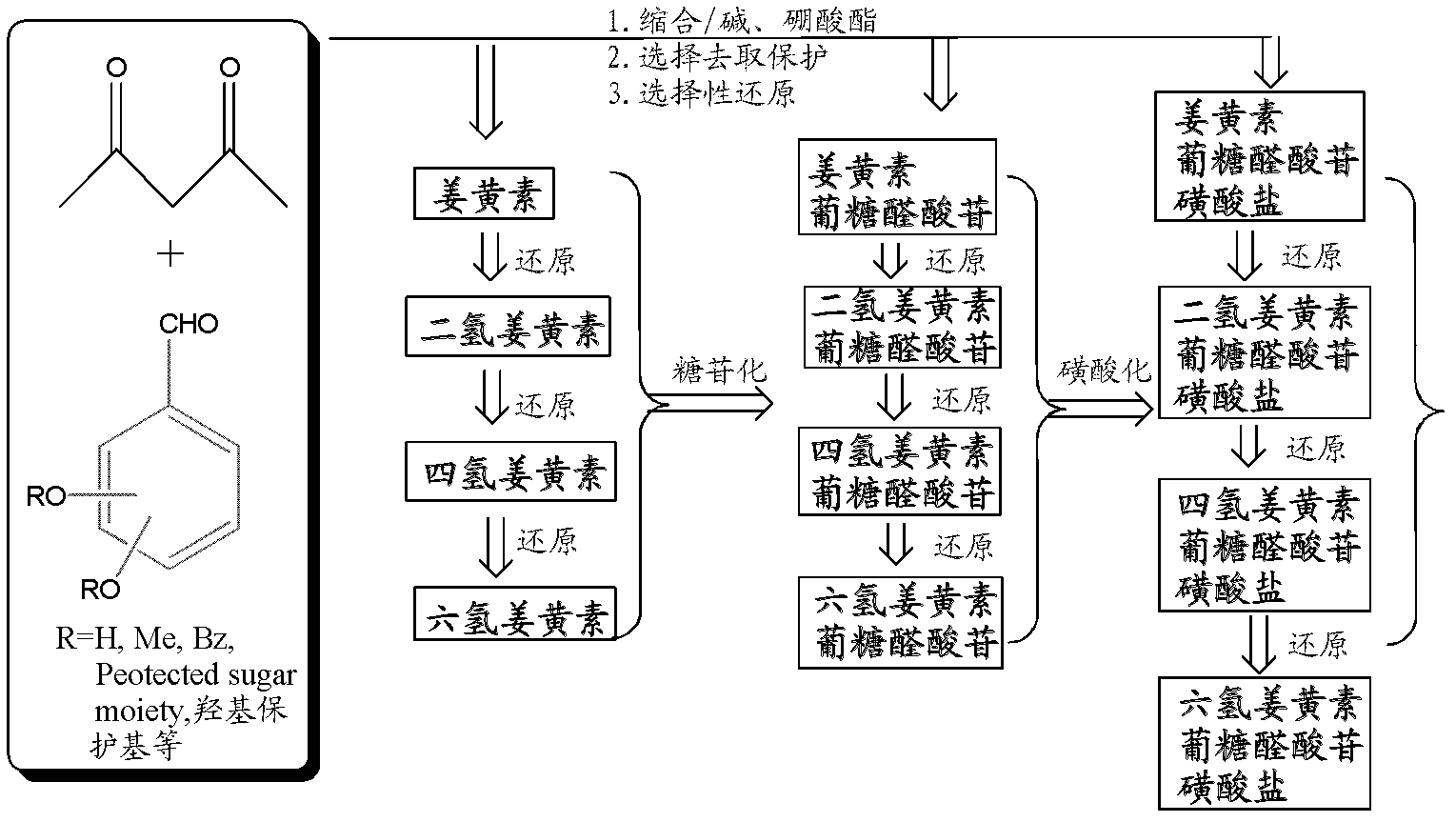Novel application of tetrahydrocurcumin
A Tetrahydrocurcumin, application technology, applied in the direction of metabolic diseases, ketone active ingredients, drug combination, etc., can solve type 2 diabetes, no tetrahydrocurcumin prevention or/and treatment of metabolic syndrome, no tetrahydrocurcumin reported Curcumin treats obese type 2 diabetes and other problems, and achieves a clear effect
- Summary
- Abstract
- Description
- Claims
- Application Information
AI Technical Summary
Problems solved by technology
Method used
Image
Examples
Embodiment 1 4
[0030] The preparation of embodiment 1 tetrahydrocurcumin compounds
[0031] through as figure 1 The synthetic route realizes the synthesis of various derivatives of tetrahydrocurcumin (curcuma longa diphenylheptanes with different double bonds, related glucuronic acid conjugates, sulfonates of glucuronic acid conjugates, etc.). This process involves three key issues: selectivity in the synthesis of various polysubstituted aldehydes; selective deprotection after full condensation of ethyl acetoacetate; and selection of hydrogenation sites in the conversion of curcumin analogues to various degrees of hydrogenation products. Due to the discovery of Lewis acid selective removal of aromatic ring hydroxyl protecting groups and multiple substitution methods of aromatic aldehydes in the past research, there are many options for solving the first and second key problems. As for the third problem, it can be realized or controlled by reduction in different stages, or by selection of di...
Embodiment 2 4
[0032] Embodiment 2 Tetrahydrocurcumin (THC) is to the effect of normal mouse appetite, body weight, blood sugar and blood fat
[0033] Experiments were performed after KM mice were adaptively fed for 3 days. Sixty mice were randomly divided into 5 groups according to fasting blood glucose level, 12 mice in each group. Establish normal control group, three dosage groups of THC (5,15,50mg / Kg), positive control group (glibenclamide 25mg / Kg), each group adopts isovolumic concentration ig administration (normal control group is given Equal volume 0.5% sodium carboxymethyl cellulose), THC three concentrations are respectively 0.05%, 0.15%, 0.5%; Positive drug concentration 0.25%. Once a day, regular administration, for 5 consecutive days. Observation indicators and detection methods: 1. Body weight (BW) was measured at a fixed time before administration and on the 5th day after administration; 2. Food intake (FI) was measured by reduction method, once a day; 3. Fasting blood gluc...
Embodiment 3 4
[0046] Embodiment 3 Tetrahydrocurcumin (THC) is to the effect of experimental metabolic syndrome rat
[0047] Experiments were carried out after SD rats were fed adaptively for 7 days. 80 rats were randomly divided into 2 groups according to body weight: 10 rats in the normal control group and 70 rats in the model group. The normal control group was fed with 4% Tween-80, and the model group was fed with fat emulsion (formula: lard 20%, cholesterol 4%, bile salt 1%, white sugar 20%, salt 8%, propylthiouracil 1%, vomiting Temperature -804%), gavage volume 1ml / 100g·BW, qd. After 6 consecutive weeks, the rats were fasted for 16 hours, and the model group was intraperitoneally injected with STZ 30mg / kg (prepared with pH 4.2, 0.1mol / L citric acid buffer solution, protected from light and ice bathed, ready to use), and the normal group An equal volume of citrate buffer was injected intraperitoneally, with an injection volume of 0.5ml / 100g·BW. After injection of STZ, the model grou...
PUM
 Login to View More
Login to View More Abstract
Description
Claims
Application Information
 Login to View More
Login to View More - R&D
- Intellectual Property
- Life Sciences
- Materials
- Tech Scout
- Unparalleled Data Quality
- Higher Quality Content
- 60% Fewer Hallucinations
Browse by: Latest US Patents, China's latest patents, Technical Efficacy Thesaurus, Application Domain, Technology Topic, Popular Technical Reports.
© 2025 PatSnap. All rights reserved.Legal|Privacy policy|Modern Slavery Act Transparency Statement|Sitemap|About US| Contact US: help@patsnap.com



